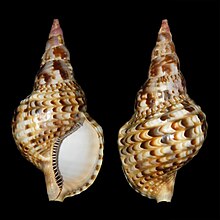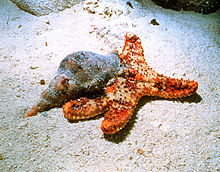Atlantic triton snail
| Atlantic triton snail | ||||||||||||
|---|---|---|---|---|---|---|---|---|---|---|---|---|

Charonia variegata , Crete , Greece (Mediterranean) |
||||||||||||
| Systematics | ||||||||||||
|
||||||||||||
| Scientific name | ||||||||||||
| Charonia variegata | ||||||||||||
| ( Lamarck , 1816) |
The Atlantic tritone snail ( Charonia variegata ) is a snail from the tritone snail family (genus Charonia ) that feeds primarily on echinoderms . It lives in the Atlantic and Mediterranean and is one of the largest snails living today.
features
The conical snail shell of Charonia variegata , which in adult snails reaches about 33 cm, sometimes 37.5 cm in length, has an elongated, pointed thread without knots. However, this is more compact than the thread of the Pacific conch Charonia tritonis . The siphon channel is very short. The younger whorls are irregularly inflated, drawn with varices and have a bulge above the seam, which descends in an irregular spiral. Parietal is a narrow, dark brown inner lip with regular, spirally arranged white folds. The outer lip has pairs of white teeth on the inside on square dark brown spots. The surface of the house is creamy white with brown crescent-shaped spots.
The body of the snail is yellowish to orange with dense dark red to brown spots. The antennae, at the widened base of which sit the eyes, are yellow with two black rings.
distribution
The Atlantic triton snail occurs on both sides of the Atlantic Ocean including the Caribbean Sea and the Mediterranean Sea . In the western Mediterranean and parts of the Atlantic, it is replaced by the knot-bearing Triton snail ( Charonia lampas ).
habitat
Charonia variegata lives in the intertidal zone and below in depths of up to at least 384 meters, also on coral reefs .
Life cycle
Like other gill snails , Atlantic triton snails are segregated. The male mates with the female with his penis . The female lays the eggs in clusters of solid oval egg capsules, from which the Veliger larvae hatch after a few weeks . The larvae go through a pelagic phase lasting more than three months , so that the snail is widely distributed via the transatlantic currents. During the metamorphosis to the finished snail, the shell is already longer than 5 mm. These are the largest known Veliger larvae in the Atlantic.
nutrition
Charonia variegata feeds primarily on echinoderms (Echinodermata). With the snail's acidic saliva, the prey animals are paralyzed and their calcareous skeletons softened. Depending on its size and consistency, the prey is swallowed whole or drilled in one place and then eaten away. Observations in Trinidad and Tobago in the 1950s showed that the triton snail has a fairly wide range of food in addition to its preferred prey, starfish and sea urchins . Sea cucumbers , mussels , snails and even young Caribbean lobsters fell victim to the Triton snails . In the latter case, a lobster still resisted when the snail was already boring a hole between the abdomen and the carapace . The preferred prey apparently also influenced the color of the shell , after having consumed the orange starfish Echinaster sentus on a massive scale, it was very colorful, while it was rather pale after the predominant consumption of sea urchins.
Danger
The Atlantic triton snail is collected because of the imposing housing. According to the German Federal Species Protection Ordinance ( Appendix 1 ), the populations of the Mediterranean are protected.
Systematics
Charonia variegata is considered by some biologists as a subspecies of Charonia tritonis , Charonia tritonis variegata , but according to WoRMS it is recognized as a separate species.
literature
- Betty Jean Piech: Ranellidae and Personidae: A Classification of Recent Species. Delaware Museum of Natural History, Wilmington Del. 1995, OCLC 33600855 , 60 pp.
- Frank Riedel: Origin and evolution of the "higher" "Caenogastropoda. Berliner Geoscientific Abhandlungen, Series E, Volume 32, Berlin 2000, ISBN 3-89582-077-6 .
Individual evidence
- ↑ a b c Sealifebase: Charonia variegata (Lamarck, 1816), Atlantic triton's trumpet
- ↑ John J. Welch: The "Island Rule" and Deep-Sea Gastropods: Re-Examining the Evidence . In: PLOS ONE . tape 5 , no. 1 , January 19, 2010, ISSN 1932-6203 , p. e8776 , doi : 10.1371 / journal.pone.0008776 .
- ↑ Example images on WoRMS : Charonia variegata, Crete (Greece), Author: Pillon, Roberto , Charonia variegata, Milos (Greece), Author: Pillon, Roberto
- ↑ Rudolph S. Scheltema: Larval dispersal as a means of genetic exchange between geographically separated populations of shallow-water benthic marine gastropods. (PDF file; 4.6 MB). In: Biol. Bull. 140, pp. 284-322, April 1971.
- ↑ Peter L. Perchade: Observations on the gastropod, Charonia variegata, in Trinidad and Tobago. In: Nautilus. Volume 85 (3), 1972, pp. 84-92, archive.org .
- ↑ mare-mundi.eu: Facts (invertebrates) - Family Ranellidae (formerly Cymatiidae), Triton snails
- ↑ In Annex 1 (to § 1) of the Federal Species Protection Ordinance No. 26, the triton horns are listed under the names Charonia tritonis ("only populations of the Mediterranean", therefore subspecies Charonia tritonis variegata ) and Charonia rubicunda , which, according to WoRMS, are synonyms for Charonia variegata and Charonia lampas are.
- ↑ World Register of Marine Species , World Marine Mollusca database: Charonia tritonis (Lamarck, 1816): accepted , Charonia tritonis variegata Lamarck, 1816: unaccepted
Web links
- Ranellidae (= Cymatiidae) - Triton shells ( Memento from November 14, 2014 in the Internet Archive ) (PDF file; 1.8 MB), p. 136: Charonia variegata (Lamarck, 1816) (identification key for the Triton snails , English, on the FAO side ). From: JHLeal: Gastropods. In: Kent E. Carpenter (Ed.): FAO Species identification guide for fishery purposes. The living marine resources of the Western Central Atlantic. Volume 1: Introduction, molluscs, crustaceans, hagfishes, sharks, batoid fishes and chimaeras. Food and Agriculture Organization of the United Nations, Rome, 2002, ISBN 978-92-5-104825-2 .
- Cymatiidae - Tritons: Charonia tritonis variegata (French, on the FAO website ). JM Gaillard: Gasteropodes. (P. 514 ff.). From: W. Fischer, M. Schneider, M.-L. Bauchot: Guide FAO d'Identification des Espèces pour les Besoins de la Pêche. Mediterranée et Mer Noire. Vol. 1, Organization des Nations Unies pour l'Alimentation et l'Agriculture, Rome, 1987, p. 570.
- Information on species protection for molluscs according to the law applicable in the Federal Republic of Germany
- jaxshells.org

